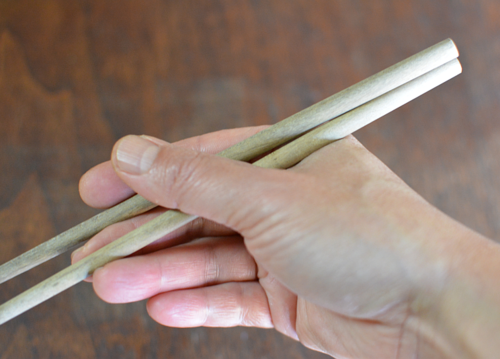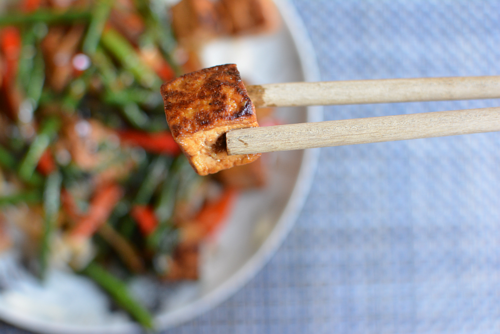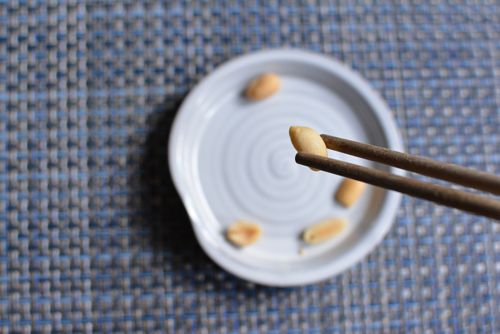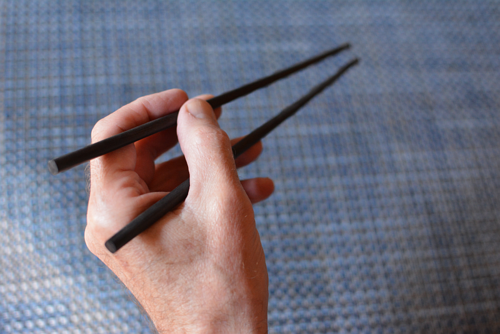A couple of my Chinese friends have chided me for how I wield chopsticks: I cross them. I always have and can’t change. Crossing the sticks to grab at my food is something I’ve done since the age of five or six. So when my dear friends told me the that crossing chopsticks was considered uncouth, I felt hurt. In fact, I asked my parents – who are persnickety about etiquette, why they didn’t correct me early on. I am too old to change. I was a victim of their negligence.
My dad looked at me as if I’d spoken like a fool. Then he said there were other eating matters that were more important to them.
That is true. What my mom drilled into us when we were young was centered on getting at food in a considerate manner. For example, if you have to pick up food from a communal plate and there isn’t a serving utensil around, turn your chopsticks around and use the clean ends. That way you are not tainting the plate. My ex-sister-in-law learned that quickly and earned points with my mom with her chopstick skills.
On the other hand, it was okay for us to use chopsticks like a knife to cross them and “cut” food into small portions that we may share. One time at dim sum, my brother worked his set of plastic chopsticks too hard trying to divide up a dumpling. The chopsticks broke and went flying into the restaurant. We pretended that we didn’t see it happen.
Do all Asians use chopsticks? No. Chopsticks are technically the major eating utensils for the four East Asian countries -- China, Japan, Korea and Vietnam. Many Southeast Asian cultures use spoon and fork for many dishes and may employ chopsticks for noodles. For a detailed low-down of Thai eating etiquette, check this post from the High Heel Gourmet. Hands are also a popular eating utensil in many parts of Asia.
Vietnamese culture and foodways are an amalgam of East and West so our table settings may include chopsticks, fork, knife, Chinese soup spoon, and regular soup spoon. Rice plates with pork chops, for example are eaten with fork and knife. A steak can be eaten with fork and knife or sliced up and enjoyed with chopsticks. We also eat with our hands (lettuce wrapped foods).
As an adult, what I focus on with chopstick usage is more practical. You’re trying to get at the food, to get it into your mouth. When guests come over and they’re unfamiliar with using chopsticks, I tell them to eat with the rice bowl. In particular, pick up the rice bowl and hold it in the air. A rice bowl on the table makes it hard to eat. Worse yet is if you try to use chopsticks to pick up rice from a plate. Everyone will finish eating before you!
I shovel food from my rice bowl in casual, family situations. With guests, I try to be graceful with the shoveling and the chopsticks. At the end of the day, I’m more concerned about whether or not people are enjoying the food and hospitality.
I’ve also learned to have fun with chopsticks. For example, my family measures chopstick skills by who can pick up a roasted peanut with a chopstick. If you can do that – and it doesn’t matter how you hold your chopsticks, you’re considered golden.
My husband passed that challenge on our first date so I knew he was a keeper. He also held his chopsticks properly. No crossing. And, he’s left handed. How did Rory learn? From studying the diagrams on the disposable chopstick sleeves. Seriously.
What are your chopstick rules or parameters?
Related post: Vietnamese table settings





















Tim Warner says
Thanks Andrea
Great article. I'm an Aussie l8ving in New Zealand and often fly to China for work. Many Chinese have said that my chopstick skills aren't bad. At least I don't go hungry.
Help to hear your insight on chopstick usage.
Thanks
Tim
Andrea Nguyen says
With good chopstick skills, you'll definitely never be far from a bite of food! Thanks for writing from so far away!
Annee Chang says
Mongolia traditionally also used chopstickes. To what extent today, though, I'm not sure.
Andrea Nguyen says
How fascinating, Annee. Maybe for noodles only? Sorry for such a late response. Your comment got buried/lost.
Lynn Iron says
Fried egg rolls. Pickup with chopstick or fingers?
Andrea Nguyen says
Anyway you can find it easy to get into your mouth. It also depends on the size and eating situation. Watch what others do.
Fredo says
Thank you for sharing this. I am writing from San Francisco with a question. A long time ago a Vietnamese friend told me that either in the past, or maybe even to this day, how high up one held their chopsticks could potentially signify social class. The higher up one held them, the more money they had. Is there any truth to that?
Andrea Nguyen says
Wow, I don't know about that one. I wonder what the height means -- like how close to the ends of the chopsticks they had their hands? That would certainly mean they were not into shoveling food in. That person should have explained the practicality of it to you a little better. Hm....
Eva Marie says
Filipinos use hands never chopsticks.
Andrea Nguyen says
Hands plus fork and spoons, yes? There's an interesting Filipino eating habits discussion here: http://ffemagazine.com/10-unique-food-habits-philippines/
If there's something missing, please share! Thank you for contributing insights.